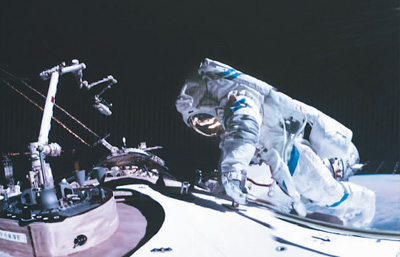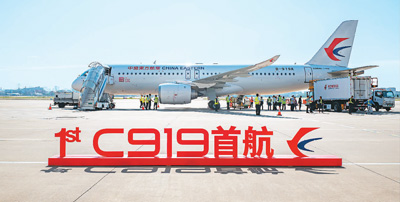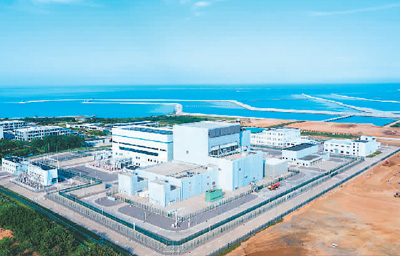China yields remarkable outcomes of sci-tech innovation in 2023
Since the beginning of 2023, a series of new inventions, technologies, products and equipment have become important driving forces for industrial upgrading and structural optimization, with sci-tech innovation continuously empowering the country's high-quality development.
This year, China achieved inspiring results in sci-tech innovation, and constantly made important original sci-tech achievements.

This photo taken at the Beijing Aerospace Control Center on Dec. 21, 2023 shows Shenzhou-17 astronaut Tang Shengjie performing extravehicular activities. (Photo/Han Qiyang)
This year marks the 20th anniversary of China's first manned spaceflight mission, Shenzhou-5. The astronauts aboard the Shenzhou-17 spaceship met with the Shenzhou-16 crew in the country's space station.
In 2023, the Experimental Advanced Superconducting Tokamak (EAST), or the Chinese "artificial sun," achieved a steady-state high confinement plasma operation for 403 seconds, a breakthrough thanks to the team of EAST, located at the Institute of Plasma Physics under the Chinese Academy of Sciences in Hefei, capital of east China's Anhui Province.
On May 28, C919, China's self-developed large passenger aircraft, completed its inaugural commercial flight, which realized the dream of the Chinese people to make their own large passenger jet. Large passenger aircraft are considered "a pearl in the modern manufacturing industry."

Photo taken on May 28, 2023 shows a C919, China's self-developed large passenger aircraft, getting ready for its first commercial flight in east China's Shanghai. (Photo/Wang Chu)
China's first offshore carbon storage project was put into operation in the South China Sea on June 1 to inject carbon dioxide from oilfields into a geological structure below the seabed, marking the country's breakthrough in technologies for storing carbon dioxide at sea. The project helps the country peak carbon dioxide emissions and achieve carbon neutrality.
China has also made breakthroughs in chip technologies. A team from the School of Integrated Circuits of Tsinghua University developed the world's first fully system-integrated memristor computing-in-memory chip that supports efficient on-chip learning, according to a research paper published in an international journal in September. With high energy efficiency, the chip is expected to meet the demand for increased computing efficiency in the era of artificial intelligence.
On Sept. 27, a solar telescope array passed key testing in southwest China. The telescope array is a landmark equipment of the country's space environment ground-base comprehensive monitoring network (phase-2 Meridian Project). It can monitor various solar eruptions and the process of solar storms entering interstellar space, which helps to predict and assess the impact of solar activity on Earth by understanding the mechanism of solar eruptions and the laws of solar storm propagation from the sun to Earth.
On Oct. 11, China's first hydrogen fuel cell-powered boat, the Three Gorges Hydrogen Boat No. 1, completed its maiden voyage in Yichang, central China's Hubei Province. It marked a breakthrough in the application of hydrogen fuel cells in the country's inland waterways.
On Nov. 24, the 6 millionth new energy vehicle (NEV) produced by China's leading NEV manufacturer BYD rolled off the production line. It took the company 13 years to make its first 1 million NEVs, but only three-plus months to produce the sixth 1 million units. China overtook Japan as the world's top auto exporter in the first half of 2023, with exports of NEVs being a highlight.
On Dec. 10, China used a Long March 2D carrier rocket to send the Yaogan-39 satellite into space from the Xichang Satellite Launch Center in southwest China's Sichuan Province, marking the 500th launch of the Long March family. It took the Long March family 37 years to conduct its first 100 launches, but only two years to conduct the fifth 100 launches.

Photo taken on June 6, 2023 shows China's first domestically-built large cruise ship "Adora Magic City" in east China's Shanghai. (Xinhua/Ding Ting)
China's first domestically-built large cruise ship, the "Adora Magic City," was delivered in Shanghai on Nov. 4. China has been able to build an aircraft carrier, a large liquified natural gas carrier and a large cruise ship -- the most challenging shipbuilding projects. The 135,500-gross-tonnage cruise ship, which is 323.6 meters long and 37.2 meters wide, consists of 107 systems, 55,000 sets of equipment, 25 million components and parts, and 4,750 kilometers of cables.
On Nov. 13, Tsinghua University announced the official operation of the world's first ultra-high-speed next-generation internet backbone with a bandwidth of 1,200G bits per second (1.2T). The overall technology level of the backbone leads the world, and the software and hardware of the backbone are made domestically.
This year, China's innovation capacity continued to improve.
China is among the 10 most innovative countries in 2023, according to a report on the global innovation ranking published by the Chinese Academy of Science and Technology for Development on Nov. 21.
The academy said that it surveyed the innovative capacities of 40 countries, which together account for more than 95 percent of global R&D investment, and over 85 percent of the global GDP.

Photo shows the exterior of the Shidaowan high temperature gas-cooled reactor (HTGR) nuclear power plant, the world's first fourth-generation nuclear power plant, which started commercial operations in Rongcheng, east China's Shandong Province on Dec. 6, 2023. (Photo/Sun Wenzhan)
China rose to 10th this year, up three slots from the 2022 rankings, and it is the only developing country to break into the top 15, the report said.
This year, China constantly optimized the environment for innovation by launching multiple policies. For instance, the country unveiled a slew of measures to strengthen the cultivation and management of young sci-tech talent, and built a fairer environment for female sci-tech talent.
Since enterprises play a leading role in sci-tech innovation, China rolled out tax breaks to help boost the enterprises' sci-tech innovation, supported private enterprises in leading technological programs in key areas, and raised their capacity to pursue scientific and technological innovation, and promoted centrally-administered state-owned enterprises to accelerate the development of strategic emerging industries. These policies and measures better stimulated the innovation vitality of enterprises.
Photos
Related Stories
- Forum held to promote Beijing-Hong Kong innovation cooperation
- UNESCO IISTEM to improve sci-tech innovation talent training in China: education ministry
- Chinese vice premier urges greater self-reliance in science, technology
- Innovation drives China's high-quality economic development
- China’s sci-tech innovations gain momentum in 2023
- China among 10 most innovative countries: report
- China boosts sci-tech innovations in dairy industry: official
Copyright © 2023 People's Daily Online. All Rights Reserved.









